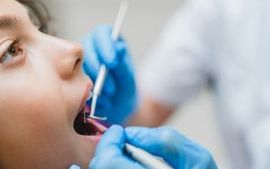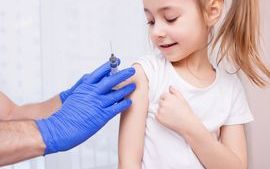- Published:
- 20 January 2025
- Author:
- Dame Rachel de Souza
- Read time:
- 5 Mins
The government has laid out a clear ambition to make this generation of children the healthiest yet – an ambition, as Children’s Commissioner, I share. I want every child to have what they need for healthy childhoods that set them up for long, happy and healthy adulthoods.
There’s been remarkable progress on children’s health over the years – medical breakthroughs, coupled with policy and cultural shifts, have made growing up in this country safer. But we’ve also seen some of that good work stall more recently – or even reverse.
Lord Darzi’s rapid review of the state of the NHS highlighted that children are getting sicker on many counts. Obesity among children aged 11–15 has steadily increased since 2014,1 and vaccine-preventable diseases are claiming more young lives as childhood immunisation rates have declined since 2013.2 Rates of children and young people with probable mental health conditions have increased substantially in recent years, from about 1 in 8 children and young people in 2017 to 1 in 5 in 2023.3,4
These are not just public health concerns – they are a failure to uphold children’s rights. Many illnesses are preventable with the right early support from health services, social care and schools.
We are at a crossroads. As the government develops its 10-year NHS plan, there is a huge opportunity to transform children’s health and wellbeing. While the factors that influence children’s health go beyond healthcare, this NHS strategy will be pivotal.
Since becoming Children’s Commissioner, I have heard from a million children and young people – it is their voices and experiences, as well as those of almost 367,000 who responded to my Big Ambition survey last year,5 which informed my response to this strategy’s consultation.
Children’s health and wellbeing must be prioritised and sufficiently funded. Children represent 24% of the population, but account for only 11% of NHS expenditure.2 On a national level, I would like to see a Joint Outcomes Framework to align public services to improve children’s health, supported by pooled funding and better local accountability. Improved data sharing is essential; I have long called for a unique identifier for children that prevents them from falling through the gaps in different services, so I am pleased that, through the Children’s Wellbeing and Schools Bill, this will become law. It is urgent and long overdue.
Community-based support is also vital. The introduction of Young Futures Hubs, modelled on Early Support Hubs, is a positive step towards moving care for children with chronic or serious health conditions away from hospitals and into community or home settings, where possible. Those that cannot receive care outside of a hospital or hospice, or are being deprived of their liberty, also deserve loving and caring integrated support from health and social care services.
The government’s 10-year plan is a chance to reshape the landscape of children’s health and wellbeing in a way that reflects their own experiences. Too often their voices and views are overlooked – we need systems designed with them, not just for them.
In recognition of Lord Darzi’s rapid review findings of a decline in children’s health, highlighted above by Dame Rachel, in this issue of the Bulletin we explore paediatric practice from the perspective of pathology specialties.
Most of us provide services to children in our laboratories, so issues in paediatric pathology and laboratory medicine deserve our particular attention. Tim Lang, Consultant Clinical Scientist in chemical pathology at the Royal Victoria Infirmary Newcastle, explains the requirements of paediatric patients in laboratory medicine, from diagnosing and identifying risk factors to developing adequate testing and sampling technologies.
Vaccination is one of the most effective public health interventions available, yet as Dame Rachel has pointed out above, coverage across many of the routine childhood programmes across the UK has been steadily declining, a highly alarming trend. Sharif Ismail and Julie Yates from the UK Health Security Agency discuss some of the long-term challenges for vaccine-preventable disease prevention and control, and review key recent and upcoming changes to the routine schedule for children and young people.
Staying with infection, James Hatcher, consultant in medical microbiology and infectious disease at Great Ormond Street Hospital for Children, highlights some key challenges in paediatric infection practice, including clinical, diagnostic and workforce issues, and considers examples of how some of these are being met. Also from Great Ormond Street Hospital, Principal Clinical Scientist in immunology Elizabeth Ralph reports on advances in the diagnosis and management of paediatric immune deficiencies.
Meanwhile, the most prevalent chronic condition of all among children is dental caries. What can be done to tackle this problem? Oral microbiology trainee Nikul Patel and dentist colleague Rosie May-Bennet address this issue.
Paediatric and perinatal pathology itself is one of the United Kingdom’s smallest specialties, with approximately 55 consultants. Together, they are responsible for reporting a very broad range of specimens from neonates to teenagers, fetal, perinatal and paediatric post mortems (including both coronial and forensic), and placental pathology. Rachel Rummery, Kerry Turner and Jens Stahlschmidt, consultant paediatric and perinatal pathologists at Leeds Teaching Hospitals NHS Trust, with Liz Hook, Honorary Consultant Paediatric Histopathologist, Cambridge University Hospitals NHS Foundation Trust, write about how paediatric and perinatal pathologists are embracing new technologies and working together to improve care for children and their families.
Finally, Tom Jacques, Professor of Paediatric Neuropathology at the UCL Great Ormond Street Institute of Child Health and Matt Clarke, NIHR Clinical Lecturer in Neuropathology at the Institute of Cancer Research, explain the dramatic changes in the field of paediatric brain tumours over recent years.
Return to January 2025 Bulletin





